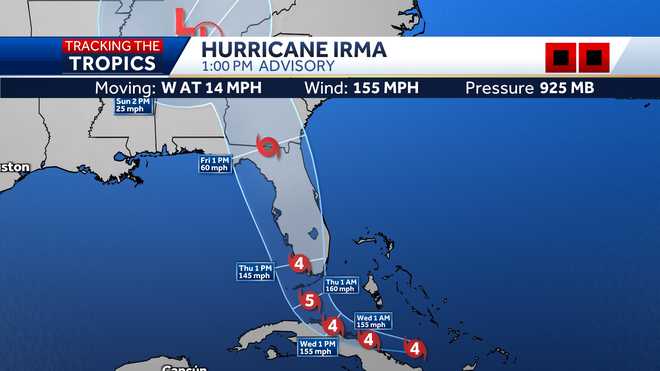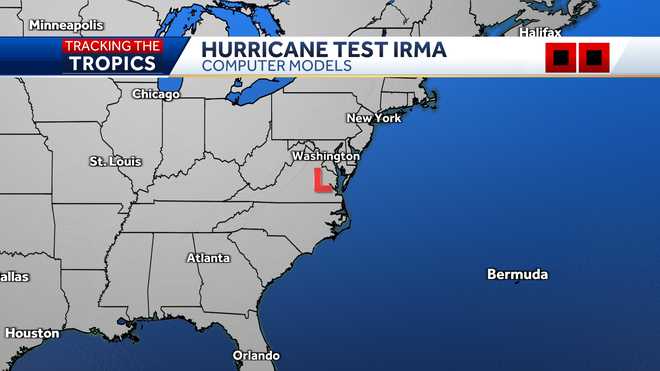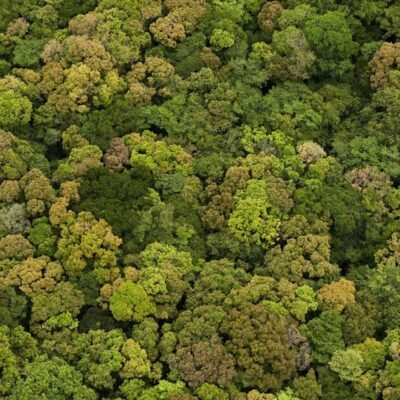ABOVE: Watch continuous live coverage of Helene from our sister station in FloridaHelene strengthened into a major Category 3 hurricane Thursday as it barreled across the Gulf of Mexico on a path to Florida.The hurricane was about 195 miles (315 kilometers) southwest of Tampa and had sustained winds of at least 111 mph (179 kph), according to the U.S. National Hurricane Center. The huge storm’s center is expected to make landfall in the Big Bend area of Florida’s northwestern coast Thursday evening.Hurricane warnings and flash flood warnings extended far beyond the coast up into south-central Georgia. The governors of Florida, Georgia, the Carolinas and Virginia have all declared emergencies in their states.Helene became a tropical storm Tuesday in the western Caribbean Sea and became a hurricane Wednesday.THIS IS A BREAKING NEWS UPDATE. AP’s earlier story follows belowFast-moving Hurricane Helene was advancing Thursday across the Gulf of Mexico toward Florida, threatening a “catastrophic” storm surge in northwestern parts of the state as well as tornadoes, damaging winds, rains and flash floods hundreds of miles inland across much of the southeastern U.S., forecasters said.Helene was upgraded Thursday morning to a Category 2 storm and is expected to be a major hurricane — meaning a Category 3 or higher — when it makes landfall on Florida’s northwestern coast Thursday evening. Tropical storm force winds already started hitting the state in advance. Hurricane warnings and flash flood warnings extended far beyond the coast up into south-central Georgia. The governors of Florida, Georgia, the Carolinas and Virginia have all declared emergencies in their states.In Florida, Gov. Ron DeSantis said Thursday morning that models suggest Helene will make landfall further east, lessening the chances for a direct hit on the capital city of Tallahassee, whose metro has a population of around 395,000.The shift has the storm aimed squarely at the sparsely-populated Big Bend area, where rain began to blow in Thursday morning along coastal U.S. Highway 98, which winds through fishing villages and vacation hideaways in this region where Florida’s panhandle and peninsula meet. Shuttered gas stations dotted the two-lane highway, their windows boarded up with plywood.Mandatory evacuation orders stretched from the panhandle south along the Gulf Coast in low-lying areas around Tallahassee, Gainesville, Cedar Key, Lake City, Tampa and Sarasota.The National Weather Service office in Tallahassee forecast storm surges of up to 20 feet and warned they could be particularly “catastrophic and unsurvivable” in Florida’s Apalachee Bay. It added that high winds and heavy rains also posed risks.Helene was about 255 miles southwest of Tampa late Thursday morning and moving north-northeast at 14 mph with top sustained winds of 105 mph. Forecasters said it should become a Category 3 or higher hurricane, meaning winds would top 110 mph.“This forecast, if realized, is a nightmare surge scenario for Apalachee Bay,” the office said. “Please, please, please take any evacuation orders seriously!”This stretch of Florida known as the Forgotten Coast has been largely spared by the widespread condo development and commercialization that dominates so many of Florida’s beach communities. The sparsely populated region is loved for its natural wonders — the vast stretches of salt marshes, tidal pools and barrier islands; the dwarf cypress trees of Tate’s Hell State Forest; and Wakulla Springs, considered one of the world’s largest and deepest freshwater springs.Anthony Godwin, 20, found one gas station outside Crawfordville where the tanks were still running Thursday morning to fill up before heading west toward his sister’s house in Pensacola.“It’s a part of life. You live down here, you run the risk of losing everything to a bad storm,” said Godwin, who lives about a half-mile from the water in the coastal town of Panacea. During Hurricane Michael in 2018, Godwin said the water came up to the end of the driveway of his family’s home when the storm surge reached about 12 feet.Along Florida’s Gulf Coast, school districts and multiple universities have canceled classes. Airports in Tampa, Tallahassee and Clearwater were closed Thursday, while cancellations were widespread elsewhere in the state and beyond.While Helene will likely weaken as it moves inland, its “fast forward speed will allow strong, damaging winds, especially in gusts, to penetrate well inland across the southeastern United States,” including in the southern Appalachian Mountains, the hurricane center said. The center posted lesser tropical storm warnings as far north as North Carolina, and warned that much of the region could experience prolonged power outages, toppled trees and dangerous flooding.Helene had swamped parts of Mexico’s Yucatan Peninsula on Wednesday, flooding streets and toppling trees as it passed offshore and brushed the resort city of Cancun.The storm formed Tuesday in the Caribbean Sea. In western Cuba, Helene knocked out power to more than 200,000 homes and businesses as it brushed past the island.Helene is forecast to be one of the largest storms in breadth in years to hit the region, said Colorado State University hurricane researcher Phil Klotzbach. He said since 1988, only three Gulf hurricanes were bigger than Helene’s predicted size: 2017’s Irma, 2005’s Wilma and 1995’s Opal.Areas 100 miles north of the Georgia-Florida line can expect hurricane conditions. More than half of Georgia’s public school districts and several universities canceled classes.For Atlanta, Helene could be the worst strike on a major Southern inland city in 35 years, said University of Georgia meteorology professor Marshall Shepherd.More than 200 miles to the south, near Valdosta, Georgia, residents filled up sandbags Thursday at a fire station as rain drizzled. Just outside town, Joe Overby boarded up a storage building as he prepared to ride out the hurricane, worrying about oaks in his yard that were damaged last year by Idalia. “I’m afraid this time they’re going to come down,” Overby said.Landslides were possible in southern Appalachia, and rainfall was expected as far away as Tennessee, Kentucky and Indiana.President Joe Biden approved an emergency declaration Thursday for Georgia after issuing one for Florida earlier in the week. Federal authorities have positioned generators, food and water, along with search-and-rescue and power restoration teams.Helene is the eighth named storm of the Atlantic hurricane season, which began June 1. The National Oceanic and Atmospheric Administration has predicted an above-average Atlantic hurricane season this year because of record-warm ocean temperatures.In further storm activity, Tropical Storm Isaac formed Wednesday in the Atlantic and was expected to strengthen as it moves eastward across the open ocean, possibly becoming a hurricane by the end of the week, forecasters said. Isaac was about 820 miles east-northeast of Bermuda with top sustained winds of 50 mph, according to the hurricane center, which said its swells and winds could affect parts of Bermuda and eventually the Azores by the weekend.In the Pacific, former Hurricane John reformed Wednesday as a tropical storm and strengthened Thursday morning back into a hurricane as it threatened areas of Mexico’s western coast with flash flooding and mudslides. Officials posted hurricane warnings for southwestern Mexico.John hit the country’s southern Pacific coast late Monday, killing at least two people, triggering mudslides, and damaging homes and trees. It grew into a Category 3 hurricane in a matter of hours and made landfall east of Acapulco. It reemerged over the ocean after weakening inland.
ABOVE: Watch continuous live coverage of Helene from our sister station in Florida
Helene strengthened into a major Category 3 hurricane Thursday as it barreled across the Gulf of Mexico on a path to Florida.
The hurricane was about 195 miles (315 kilometers) southwest of Tampa and had sustained winds of at least 111 mph (179 kph), according to the U.S. National Hurricane Center. The huge storm’s center is expected to make landfall in the Big Bend area of Florida’s northwestern coast Thursday evening.
Hurricane warnings and flash flood warnings extended far beyond the coast up into south-central Georgia. The governors of Florida, Georgia, the Carolinas and Virginia have all declared emergencies in their states.
Helene became a tropical storm Tuesday in the western Caribbean Sea and became a hurricane Wednesday.
THIS IS A BREAKING NEWS UPDATE. AP’s earlier story follows below
Fast-moving Hurricane Helene was advancing Thursday across the Gulf of Mexico toward Florida, threatening a “catastrophic” storm surge in northwestern parts of the state as well as tornadoes, damaging winds, rains and flash floods hundreds of miles inland across much of the southeastern U.S., forecasters said.
Helene was upgraded Thursday morning to a Category 2 storm and is expected to be a major hurricane — meaning a Category 3 or higher — when it makes landfall on Florida’s northwestern coast Thursday evening. Tropical storm force winds already started hitting the state in advance. Hurricane warnings and flash flood warnings extended far beyond the coast up into south-central Georgia. The governors of Florida, Georgia, the Carolinas and Virginia have all declared emergencies in their states.
In Florida, Gov. Ron DeSantis said Thursday morning that models suggest Helene will make landfall further east, lessening the chances for a direct hit on the capital city of Tallahassee, whose metro has a population of around 395,000.
The shift has the storm aimed squarely at the sparsely-populated Big Bend area, where rain began to blow in Thursday morning along coastal U.S. Highway 98, which winds through fishing villages and vacation hideaways in this region where Florida’s panhandle and peninsula meet. Shuttered gas stations dotted the two-lane highway, their windows boarded up with plywood.
Mandatory evacuation orders stretched from the panhandle south along the Gulf Coast in low-lying areas around Tallahassee, Gainesville, Cedar Key, Lake City, Tampa and Sarasota.
The National Weather Service office in Tallahassee forecast storm surges of up to 20 feet and warned they could be particularly “catastrophic and unsurvivable” in Florida’s Apalachee Bay. It added that high winds and heavy rains also posed risks.
Helene was about 255 miles southwest of Tampa late Thursday morning and moving north-northeast at 14 mph with top sustained winds of 105 mph. Forecasters said it should become a Category 3 or higher hurricane, meaning winds would top 110 mph.
“This forecast, if realized, is a nightmare surge scenario for Apalachee Bay,” the office said. “Please, please, please take any evacuation orders seriously!”
This stretch of Florida known as the Forgotten Coast has been largely spared by the widespread condo development and commercialization that dominates so many of Florida’s beach communities. The sparsely populated region is loved for its natural wonders — the vast stretches of salt marshes, tidal pools and barrier islands; the dwarf cypress trees of Tate’s Hell State Forest; and Wakulla Springs, considered one of the world’s largest and deepest freshwater springs.
Anthony Godwin, 20, found one gas station outside Crawfordville where the tanks were still running Thursday morning to fill up before heading west toward his sister’s house in Pensacola.
“It’s a part of life. You live down here, you run the risk of losing everything to a bad storm,” said Godwin, who lives about a half-mile from the water in the coastal town of Panacea. During Hurricane Michael in 2018, Godwin said the water came up to the end of the driveway of his family’s home when the storm surge reached about 12 feet.
Along Florida’s Gulf Coast, school districts and multiple universities have canceled classes. Airports in Tampa, Tallahassee and Clearwater were closed Thursday, while cancellations were widespread elsewhere in the state and beyond.
While Helene will likely weaken as it moves inland, its “fast forward speed will allow strong, damaging winds, especially in gusts, to penetrate well inland across the southeastern United States,” including in the southern Appalachian Mountains, the hurricane center said. The center posted lesser tropical storm warnings as far north as North Carolina, and warned that much of the region could experience prolonged power outages, toppled trees and dangerous flooding.
Helene had swamped parts of Mexico’s Yucatan Peninsula on Wednesday, flooding streets and toppling trees as it passed offshore and brushed the resort city of Cancun.
The storm formed Tuesday in the Caribbean Sea. In western Cuba, Helene knocked out power to more than 200,000 homes and businesses as it brushed past the island.
Helene is forecast to be one of the largest storms in breadth in years to hit the region, said Colorado State University hurricane researcher Phil Klotzbach. He said since 1988, only three Gulf hurricanes were bigger than Helene’s predicted size: 2017’s Irma, 2005’s Wilma and 1995’s Opal.
Areas 100 miles north of the Georgia-Florida line can expect hurricane conditions. More than half of Georgia’s public school districts and several universities canceled classes.
For Atlanta, Helene could be the worst strike on a major Southern inland city in 35 years, said University of Georgia meteorology professor Marshall Shepherd.
More than 200 miles to the south, near Valdosta, Georgia, residents filled up sandbags Thursday at a fire station as rain drizzled. Just outside town, Joe Overby boarded up a storage building as he prepared to ride out the hurricane, worrying about oaks in his yard that were damaged last year by Idalia. “I’m afraid this time they’re going to come down,” Overby said.
Landslides were possible in southern Appalachia, and rainfall was expected as far away as Tennessee, Kentucky and Indiana.
President Joe Biden approved an emergency declaration Thursday for Georgia after issuing one for Florida earlier in the week. Federal authorities have positioned generators, food and water, along with search-and-rescue and power restoration teams.
Helene is the eighth named storm of the Atlantic hurricane season, which began June 1. The National Oceanic and Atmospheric Administration has predicted an above-average Atlantic hurricane season this year because of record-warm ocean temperatures.
In further storm activity, Tropical Storm Isaac formed Wednesday in the Atlantic and was expected to strengthen as it moves eastward across the open ocean, possibly becoming a hurricane by the end of the week, forecasters said. Isaac was about 820 miles east-northeast of Bermuda with top sustained winds of 50 mph, according to the hurricane center, which said its swells and winds could affect parts of Bermuda and eventually the Azores by the weekend.
In the Pacific, former Hurricane John reformed Wednesday as a tropical storm and strengthened Thursday morning back into a hurricane as it threatened areas of Mexico’s western coast with flash flooding and mudslides. Officials posted hurricane warnings for southwestern Mexico.
John hit the country’s southern Pacific coast late Monday, killing at least two people, triggering mudslides, and damaging homes and trees. It grew into a Category 3 hurricane in a matter of hours and made landfall east of Acapulco. It reemerged over the ocean after weakening inland.









